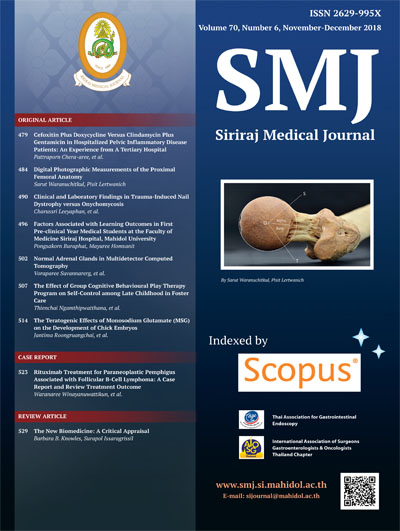Clinical and Laboratory Findings in Trauma-Induced Nail Dystrophy versus Onychomycosis
Keywords:
Onychomycosis; trauma-induced nail dystrophy; fungal foot infection; dermatophytosis; hallux valgusAbstract
Objective: The study aims to investigate prevalence, clinical characteristics, and laboratory findings of traumatic toenails in comparison with those of onychomycosis.
Methods: This cross-sectional study included hallux valgus (HV) patients attending Foot Clinic. Descriptive statistics, Chi-square test, Student’s t-test and Mann-Whitney U test were used in statistical analysis.
Results: A total of 81 patients with a mean age of 65 years old, of which 77 were females (95.1%), were enrolled. The prevalence of onychomycosis was 25.9%, whereas that of trauma-induced nail dystrophy was 55.6%. There were 18 (22.2%) patients with fungal feet infection. Among 21 patients with nail infections, three had subclinical presentation. Fifteen patients (71.4%) with onychomycosis were infected with dermatophytes (DMPs). The others were caused by nondermatophytes (NDMs), of which 14.2% were Neoscytalidium dimidiatum. Comparing with traumatic nail, statistical analysis revealed HV angle of greater than 30 degrees and the presence of fungal foot infection to be significantly associated with onychomycosis (p=.011 and p<.001, respectively).
Conclusion: One-fourth of HV patients had onychomycosis. Severe foot deformities and concomitant fungal foot infection were significantly associated with onychomycosis. Holistic foot and nail examination is essential for distinguishing onychomycosis and traumatic induced nail dystrophy. Subclinical presentation was common.
Downloads
Published
How to Cite
Issue
Section
License
Authors who publish with this journal agree to the following conditions:
Copyright Transfer
In submitting a manuscript, the authors acknowledge that the work will become the copyrighted property of Siriraj Medical Journal upon publication.
License
Articles are licensed under a Creative Commons Attribution-NonCommercial-NoDerivatives 4.0 International License (CC BY-NC-ND 4.0). This license allows for the sharing of the work for non-commercial purposes with proper attribution to the authors and the journal. However, it does not permit modifications or the creation of derivative works.
Sharing and Access
Authors are encouraged to share their article on their personal or institutional websites and through other non-commercial platforms. Doing so can increase readership and citations.











